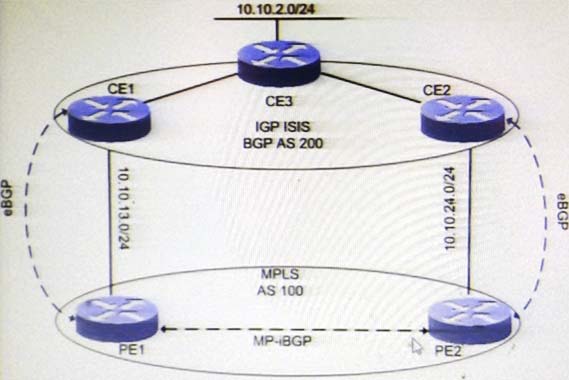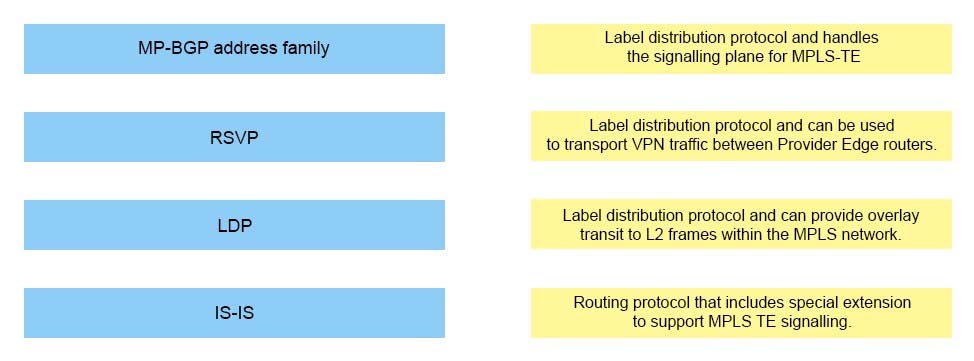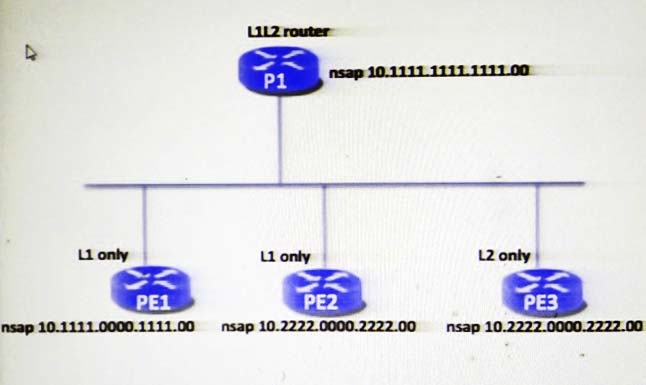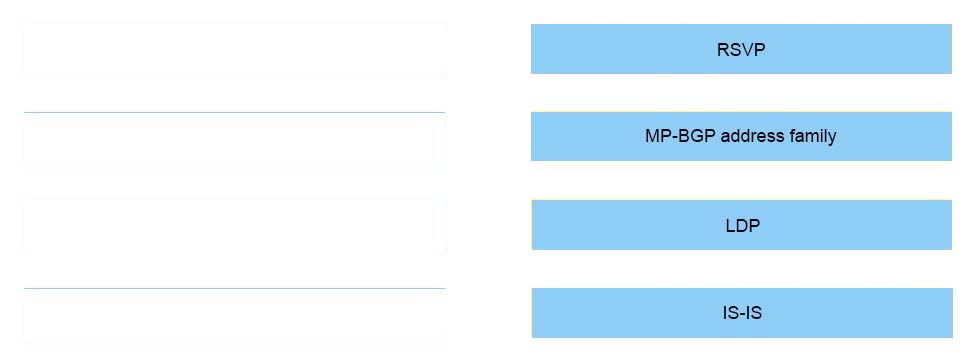Cisco® 400-201 Exam Practice Questions (P. 3)
- Full Access (446 questions)
- Six months of Premium Access
- Access to one million comments
- Seamless ChatGPT Integration
- Ability to download PDF files
- Anki Flashcard files for revision
- No Captcha & No AdSense
- Advanced Exam Configuration
Question #21

Refer to the exhibit. A customer is running IS-IS within a network and is using BGP as a CE-PE routing protocol. Which action allows CE1 to get the subnet
10.10.2.0/24 over the CE1-PE1 link regardless of whether there is a flap in the MPLS link or backdoor link?
- AConfigure the distance bgp 115 200 200command on CE2 under the BGP process.
- BConfigure the distance bgp 115 200 200command on CE1 under the BGP process.
- CConfigure the neighbor <PE2-IP> weight 33768command on CE2 under the BGP process.
- DConfigure the neighbor <PE1-IP> weight 33768command on CE1 under the BGP process
Correct Answer:
B
B
send
light_mode
delete
Question #22
Which two BGP mechanisms solve the BGP full-mesh paradigm? (Choose two.)
- ABGP link state
- BMPLS VPN
- Croute reflectors
- Dhierarchical VPLS
- Econfederation
- Froute policy filtering
- Gcommunity SOO
Correct Answer:
CE
CE
send
light_mode
delete
Question #23
Two routers that are running MPLS and LDP have multiple links that than connect them to each other. An engineer wants to ensure that the label bindings are not flushed from the LIB if one of the links fails. Which configuration meets this requirement?
- Athempls ldpautoconfigcommand
- Bthempls ipcommand on an MPLS TE tunnel
- Cthempls ldp synccommand under router process configuration mode
- Dthempls ldp discoverytargeted-hello accept command
Correct Answer:
D
D
send
light_mode
delete
Question #24
Drag and drop the service provider MPLS core component on the left onto the matching functionality on the right.
Select and Place:

Select and Place:

send
light_mode
delete
Question #25
What is the advantage of BGP confederation implementation compared to BGP route reflector implementation?
- AConfederation allows use of template session and template policy. Route reflector can use only peer-group.
- BConfederation provides better redundancy. Route reflector clients can peer to only one cluster.
- CThe IBGP policies can differ internally within and between subautonomous systems.
- DConfederation is more scalable. Route reflector implementation still requires confederation to eliminate completely the full mesh requirement.
Correct Answer:
C
References:
C
References:
send
light_mode
delete
Question #26
A service provider is in the process of providing Layer 2 and Layer 3 VPN services through a MPLS LDP-enabled backbone. With load increasing in the service provider domain, scalability become the most important. Based on the local label allocation filtering feature, which is the lower subset of prefixes must be selected to meet these requirements?
- ARR, P, and PE loopbacks that are used as BGP next hop
- Ball/32 prefixes advertised in the IGP
- CP and PE loopbacks that are used as BGP next hop
- DCE loopbacks only that are used as BGP next hop
Correct Answer:
A
A
send
light_mode
delete
Question #27
A service provider offers four classes of service for MPLS VPN customer with the following IPP/EXP values: i. voice = 5 ii. video = 4 iii. priority data = 3 iv. best-effort data = 0
The service-provider also supports multicast VPN services in the priority data and best-effort classes. Multicast VPN is implemented as a draft-rosen profile. On a
P router, in the MPLS core, the ingress QoS policy-map must classify all incoming packets, so that different classes of traffic can be property handled in fabric queues and egress queues. All types of packets in the core network must be covered.
Which ingress classification offers the optimal performance and provides the minimum number of actions that match the service provider QoS requirements?
The service-provider also supports multicast VPN services in the priority data and best-effort classes. Multicast VPN is implemented as a draft-rosen profile. On a
P router, in the MPLS core, the ingress QoS policy-map must classify all incoming packets, so that different classes of traffic can be property handled in fabric queues and egress queues. All types of packets in the core network must be covered.
Which ingress classification offers the optimal performance and provides the minimum number of actions that match the service provider QoS requirements?
- Aclass-map match-any VOICE match mpls experimental topmost 5 class-map match-any VIDEO match mpls experimental topmost 4 class-map match-any CONTROL match mpls experimental topmost 6 7 class-map match-any PRIORITY match mpls experimental topmost 3 ! policy-map INGRESS class VOICE set gos-group 5 class VIDEO set gos-group 4 class CONTROL set gos-group 6 class PRIORITYset gos-group 3 class class-default
- Bclass-map match-any VOICE match mpls experimental topmost 5 match precedence ipv4 flash-override class-map match-any VIDEO match mpls experimental topmost 4 match precedence ipv4 critical class-map match-any CONTROL match precedence ipv4 internet network class-map match-any PRIORITY match mpls experimental topmost 3 match precedence ipv4 flash ! policy-map INGRESS class VOICE set gos-group 5class VIDEO set gos-group 4 class CONTROL set gos-group 6 class PRIORITYset gos-group 3 class class-default
- Cclass-map match-any VOICE match mpls experimental topmost 5 class-map match-any VIDEO match mpls experimental topmost 4 class-map match-any CONTROL class-map match-any PRIORITY match mpls experimental topmost 3match precedence ipv4 flash ! policy-map INGRESS class VOICE setg os-group 5class VIDEO set gos-group 4 class CONTROL set gos-group 6 class PRIORITY set gos-group 3 class class-default
- Dclass-map match-any VOICE match precedence ipv4 critical class-map match-any VIDEO match precedence ipv4 flash-override class-map match-any PRIOTIRY match mpls experimental topmost 3 match precedence ipv4 flash ! policy-map INGRESS class VOICE set qos-group 5 class VIDEO set qos-group 4 class PRIORITY set qos-group 3 class class-default
Correct Answer:
A
A
send
light_mode
delete
Question #28
A Layer 3 VPN customer opened a case that reports connectivity loss with remote sites. An operations engineer realized this connectivity loss happened after the
LDP label filtering was applied. What is the root cause of this issue?
LDP label filtering was applied. What is the root cause of this issue?
- ALabels were not allocated for the P loopbacks.
- BLabels were not allocated for the P and PE physical interfaces.
- CLabels were not allocated for the PE loopbacks.
- DLabels were not allocated for the PE, P and RR physical interfaces.
- ELabels were not allocated for the PE, P and RR loopbacks.
- FLabels were not allocated for the CE loopbacks and physical interfaces.
Correct Answer:
E
E
send
light_mode
delete
Question #29

Refer to the exhibit. The P1 router is elected as the DIS on the broadcast link. Assuming that all the configurations are applied correctly, how many routers will establish IS-IS neighborship with P1 router on this broadcast link?
send
light_mode
delete
Question #30

Refer to the exhibit. PIM sparse mode is implemented in the network. RPF succeeds under which condition?
- AThe RPF check succeeds for both PIM neighbors, and traffic load-balances across both neighbors.
- BThe RPF check succeeds for the next hop whose router ID is the highest.
- CThe RPF check succeeds for the highest DR priority for the PIM router.
- DThe RPF check succeeds for the highest interface IP address for the PIM router.
Correct Answer:
D
D
send
light_mode
delete
All Pages

